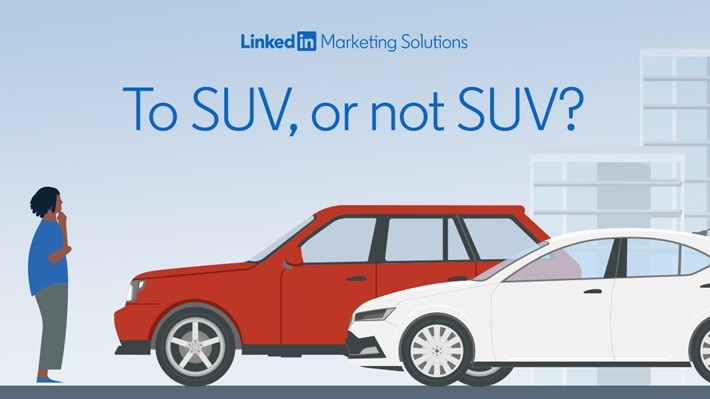Trends, tips, and best practices
To SUV, or not SUV?
Doesn’t time fly? It was just over 12 months ago that the British Society of Motor Manufacturers and Traders had announced that year on year sales had tanked by more than 97%. The memory is still enough to make you shudder.
The good news for the automotive industry is that green shoots are starting to appear. The European Automobile Manufacturers’ Association (ACEA) expects the car market to pick up in a matter of months as vaccination programmes continue to move at a rapid pace.
In North America, automotive ad spend is expected to grow by more than 20% in 2021 thanks to a culmination of stimulus checks, vaccinations and low interest rates. And as lockdowns ease around the world, similar factors are expected to improve consumer confidence in the LATAM market.
But while this means that dealerships can start looking forward to operating again soon, LinkedIn members are already showing significant purchase intent. Specifically, our latest survey showed that two-thirds of LinkedIn users in EMEA and LATAM haven’t changed their intentions of purchasing a car due to the pandemic, and another 4% would actually like to purchase sooner.
Crucially, the consumer market has warmed quickly to the concept of buying online. It will have escaped no one’s notice that the shift towards digital channels in the last year has been extraordinary. The automotive industry has begun to learn its own lessons too. By improving digital engagement with car buyers in the UK, dealers were able to mitigate the impact of the pandemic later in the year.
So with LinkedIn being a key touchpoint on the digital customer journey for many buyers, what are the trends to capitalise on?
Members’ interest in SUVs has skyrocketed
To help assess the market landscape, we recently partnered with Sophus3, a company with unparalleled experience delivering benchmarking and analytics solutions to automotive manufacturers.
Thanks to their analysis of visitor behaviour on the websites of automotive OEMs, we found that the SUV segment was recovering at a markedly faster rate than the rest of the market. In fact, of the websites we analysed, SUVs captured 49% of all visits.
Now, the popularity of SUVs has been growing over the last decade, from 10% of European sales in 2010 up to 33% by 2018, and from 27% to 48% of sales in the US market.
But that popularity has accelerated even further in the last three years. Here on LinkedIn, user engagements with SUV automotive content have increased nine-fold since 2018.
What’s more, we have found that 75% of LinkedIn members across Europe, the Middle East and Latin America would consider an SUV model for their next car purchase.
So what is the appeal to our users? Unsurprisingly, the most commonly cited reasons relate to larger size and comfort – in line with most other demographics. But we also see the themes of family and safety resonating well with LinkedIn members.
And with the pandemic restricting indoor pastimes for the vast majority of the world’s population, it’s interesting to note that SUVs’ off-road capabilities have also become more highly valued by our users.
Capitalise on the convergence of EV and SUV
One trend that noticeably grew last year was the market share of electrically-chargeable vehicles. According to the ACEA, the EU-wide market share of EVs tripled in 2020 compared to the previous year, reaching 10.5% against 3% in 2019.
Again, LinkedIn users are very much ahead of the curve, with a third of members saying they are already looking for an electric or hybrid SUV model. In fact, the Audi e-tron, its first fully electric SUV (eSUV) launched in 2019, is currently the most mentioned SUV model on LinkedIn this year.
The appetite for greener, larger vehicles is only going to grow. Five out of Autocar’s top ten family SUVs currently mention some kind of hybrid option, but realistically this is just a stepping stone to an inevitable boom in demand for full eSUV models.
Because as the EV technology matures, so too will the number of consumers requiring vehicles that deliver the space and performance they need while further reducing the impact on the climate.
At least, that’s what our 756 million members are telling us.
Explore the full research findings and learn more about the SUV opportunity here.
Topics: Trends, tips, and best practices
Related articles


